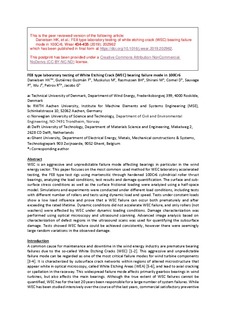| dc.contributor.author | Danielsen, H. K. | |
| dc.contributor.author | Guzmán, F. G. | |
| dc.contributor.author | Muskulus, Michael | |
| dc.contributor.author | Rasmussen, B. H. | |
| dc.contributor.author | Shirani, M. | |
| dc.contributor.author | Cornel, D. | |
| dc.contributor.author | Sauvage, P. | |
| dc.contributor.author | Wu, J. | |
| dc.contributor.author | Petrov, R. V. | |
| dc.contributor.author | Jacobs, G. | |
| dc.date.accessioned | 2019-08-19T10:29:01Z | |
| dc.date.available | 2019-08-19T10:29:01Z | |
| dc.date.created | 2019-08-08T09:57:37Z | |
| dc.date.issued | 2019 | |
| dc.identifier.citation | Wear. 2019, 434-435 . | nb_NO |
| dc.identifier.issn | 0043-1648 | |
| dc.identifier.uri | http://hdl.handle.net/11250/2608964 | |
| dc.description.abstract | WEC is an aggressive and unpredictable failure mode affecting bearings in particular in the wind energy sector. This paper focuses on the most common used method for WEC laboratory accelerated testing, the FE8 type test rigs using martensitic through hardened 100Cr6 cylindrical roller thrust bearings, analyzing the load conditions, test results and damage quantification. The surface and sub-surface stress conditions as well as the surface frictional loading were analyzed using a half-space model. Simulations and experiments were conducted under different load conditions, including tests with different number of rollers and tests using dynamic load and speed. Tests under constant loads show a low load influence and prove that a WEC failure can occur both prematurely and after exceeding the rated lifetime. Dynamic conditions did not accelerate WEC failure, and only rollers (not washers) were affected by WEC under dynamic loading conditions. Damage characterization was performed using optical microscopy and ultrasound scanning. Advanced image analysis based on characterization of defect regions in the ultrasound scans was used for quantifying the subsurface damage. Tests showed WEC failure could be achieved consistently, however there were seemingly large random variations in the observed damage. | nb_NO |
| dc.language.iso | eng | nb_NO |
| dc.publisher | Elsevier | nb_NO |
| dc.rights | Attribution-NonCommercial-NoDerivatives 4.0 Internasjonal | * |
| dc.rights.uri | http://creativecommons.org/licenses/by-nc-nd/4.0/deed.no | * |
| dc.title | FE8 type laboratory testing of white etching crack (WEC) bearing failure mode in 100Cr6 | nb_NO |
| dc.type | Journal article | nb_NO |
| dc.type | Peer reviewed | nb_NO |
| dc.description.version | acceptedVersion | nb_NO |
| dc.source.pagenumber | 13 | nb_NO |
| dc.source.volume | 434-435 | nb_NO |
| dc.source.journal | Wear | nb_NO |
| dc.identifier.doi | 10.1016/j.wear.2019.202962 | |
| dc.identifier.cristin | 1714755 | |
| dc.description.localcode | © 2019. This is the authors’ accepted and refereed manuscript to the article. Locked until 11.7.2021 due to copyright restrictions. This manuscript version is made available under the CC-BY-NC-ND 4.0 license http://creativecommons.org/licenses/by-nc-nd/4.0/ | nb_NO |
| cristin.unitcode | 194,64,91,0 | |
| cristin.unitname | Institutt for bygg- og miljøteknikk | |
| cristin.ispublished | true | |
| cristin.fulltext | postprint | |
| cristin.qualitycode | 1 | |

